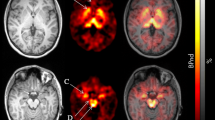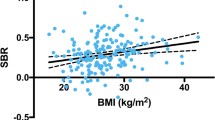Abstract
Rationale
Serotonin (5-HT) is involved in the control of eating behaviour by inhibiting food intake. Obese women with binge-eating disorder (OB-BED) were recently found to have reduced 5-HT transporter binding.
Objectives
The aim of this study was to investigate the effect of a successful treatment on 5-HT transporters in OB-BED.
Methods
The 5-HT transporter binding of seven OB-BED was measured by single-photon emission computed tomography (SPECT), by using iodine-123-labelled nor-β-CIT as a tracer, before treatment and after successful treatment, when the OB-BED were asymptomatic. Treatment consisted of group psychotherapy and fluoxetine medication. The control subjects, six obese women without eating disorders, were also studied twice by using SPECT.
Results
The 5-HT transporter binding of the symptomatically recovered OB-BED increased significantly (24±22%) after treatment, whereas in the control group, binding remained unchanged.
Conclusions
The results tentatively suggest that 5-HT transporter binding in OB-BED is an adaptive mechanism, which can be affected by treatment. Furthermore, there seems to be a link between improved 5-HT transporter binding and reduced binge eating.


Similar content being viewed by others
References
American Psychiatric Association (1994) Diagnostic and Statistical Manual of Mental Disorders, 4th edn. American Psychiatric Association, Washington D.C.
Beck AT, Ward CH, Mendelson M, Mock J, Erbaugh J (1961) An inventory for measuring depression. Arch Gen Psychiatry 4:53–63
Fairburn CG, Cooper Z (1993) The Eating Disorder Examination. In: Fairburn CG, Wilson GT (eds) Binge eating: nature, assessment, and treatment. Guilford, New York, pp 317–332
Gormally J, Black S, Daston S, Rardin D (1982) The assessment of binge eating severity among obese persons. Addict Behav 7:47–55
Henderson M, Freeman CP (1987) A self-rating scale for bulimia. The BITE. Br J Psychiatry 150:18–24
Kaye WH, Greeno CG, Moss H, Fernstrom J, Fernstrom M, Lilenfeld LR, Weltzin TE, Mann JJ (1998) Alterations in serotonin activity and psychiatric symptoms after recovery from bulimia nervosa. Arch Gen Psychiatry 55:927–935
Kuikka JT, Tammela L, Bergstrom KA, Karhunen L, Uusitupa M, Tiihonen J (2001a) Effects of ageing on serotonin transporters in healthy females. Eur J Nucl Med 28:911–913
Kuikka JT, Tammela L, Karhunen L, Rissanen A, Bergstrom KA, Naukkarinen H, Vanninen E, Karhu J, Lappalainen R, Repo-Tiihonen E, Tiihonen J, Uusitupa M (2001b) Reduced serotonin transporter binding in binge eating women. Psychopharmacology 155:310–314
Leibowitz SF, Alexander JT (1998) Hypothalamic serotonin in control of eating behavior, meal size, and body weight. Biol Psychiatry 44:851–864
Pirker W, Asenbaum S, Hauk M, Kandlhofer S, Tauscher J, Willeit M, Neumeister A, Praschak-Rieder N, Angelberger P, Brucke T (2000) Imaging serotonin and dopamine transporters with 123I-beta-CIT SPECT: binding kinetics and effects of normal aging. J Nucl Med 41:36–44
Spitzer RL, Yanovski S, Wadden T, Wing R, Marcus MD, Stunkard A, Devlin M, Mitchell J, Hasin D, Horne RL (1993) Binge eating disorder: its further validation in a multisite study. Int J Eat Disord 13:137–153
Steiger H, Young SN, Kin NM, Koerner N, Israel M, Lageix P, Paris J (2001) Implications of impulsive and affective symptoms for serotonin function in bulimia nervosa. Psychol Med 31:85–95
Tauscher J, Pirker W, de Zwaan M, Asenbaum S, Brucke T, Kasper S (1999) In vivo visualization of serotonin transporters in the human brain during fluoxetine treatment. Eur Neuropsychopharmacol 9:177–179
Tauscher J, Pirker W, Willeit M, de Zwaan M, Bailer U, Neumeister A, Asenbaum S, Lennkh C, Praschak-Rieder N, Brucke T, Kasper S (2001) [123I] beta-CIT and single photon emission computed tomography reveal reduced brain serotonin transporter availability in bulimia nervosa. Biol Psychiatry 49:326–332
van Dyck CH, Malison RT, Seibyl JP, Laruelle M, Klumpp H, Zoghbi SS, Baldwin RM, Innis RB (2000) Age-related decline in central serotonin transporter availability with [123I] beta-CIT SPECT. Neurobiol Aging 21:497–501
Acknowledgements
The study was supported by grants from the Kuopio University Hospital (EVO-5136), the Finnish Cultural Foundation (00011067) and the Academy of Finland, Research Council for Health (28327). The authors thank the personnel of the Department of Clinical Physiology and Nuclear Medicine.
Author information
Authors and Affiliations
Corresponding author
Rights and permissions
About this article
Cite this article
Tammela, L.I., Rissanen, A., Kuikka, J.T. et al. Treatment improves serotonin transporter binding and reduces binge eating. Psychopharmacology 170, 89–93 (2003). https://doi.org/10.1007/s00213-003-1519-6
Received:
Accepted:
Published:
Issue Date:
DOI: https://doi.org/10.1007/s00213-003-1519-6




